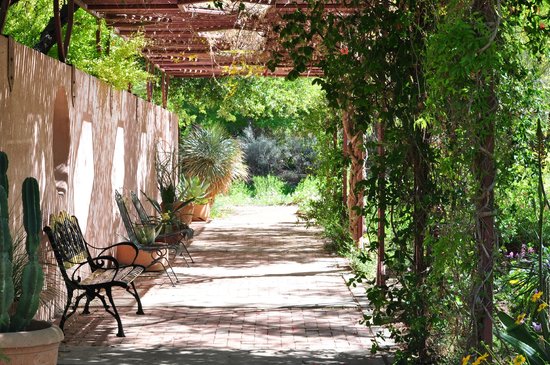


Boyce Thompson Arboretum is the largest and oldest botanical garden in the state of Arizona. It is one of the oldest botanical institutions west of the Mississippi.
The collections include plants from the United States, Mexico, Australia, Madagascar, India, China, Japan, Israel, South America, the Middle East, Africa, the Mediterranean, and the Arabian Peninsula—all told 3,900 taxa and 19,000 plants within 135 acres of gardens. We highlight twelve of our gardens and exhibits below.
Located three miles west of Superior, Boyce Thompson Arboretum is Arizona’s oldest and largest botanical garden. The 323-acre parcel is filled to the brim with plants from deserts around the world, and offers visitors an up-close-and-personal look at desert flora and fauna in the a variety of landscapes. From sheer mountain cliffs to a streamside forest, there’s a wide selection of habitats for wheelchair-users and slow walkers to explore. And since the park is just 65 miles east of Phoenix, it makes an excellent day trip from the city, as well as a fun road trip stop on a cross-Arizona trek.
May thru September Open Daily 6:00 a.m. to 3:00 p.m.
(Last admission 2 PM) Closed July 4
October thru April Open Daily 8:00 a.m. to 5:00 p.m.
(Last admission 4 PM) Closed Thanksgiving Day and Christmas Day
General Guidelines
Please follow these guidelines to make your visit safe and enjoyable:
Access is relatively good throughout this popular Arizona botanical garden, with accessible parking in front and barrier-free access over to the visitor center. Inside there’s plenty of room to maneuver a wheelchair around the exhibits, and to the accessible restrooms, which are located in the rear of the building. There’s also barrier-free access to the gift shop, which offers souvenirs, gifts, drinks, snacks and sandwiches.
If you’d prefer to bring you own picnic lunch, accessible picnic tables are located near the Demonstration Garden, across the street from the visitor center. Accessible parking is located nearby, with a level path over to the shaded tables. It’s a pleasant, peaceful spot to enjoy a noontime repast.
Save some time to visit the Demonstration Garden after lunch. There’s level access throughout the garden which offers design and plant selection ideas for a variety of landscapes. Before you set out to explore the rest of the botanical garden, make sure you have an ample supply of water and a hat, as shade is in short supply, and the midday sun can be harsh.
Trek to Ayer Lake
Most of the Main Trail through the botanical garden is doable for wheelchair-users and slow walkers, as this hard-packed dirt trail is wide and fairly level. It begins near the visitor center and allows visitors access to a number of other gardens along the route.
The Hummingbird and Butterfly Garden, which is located close to the visitor center, offers good access for wheelchair-users and slow walkers. The nearby Heritage Rose Garden also has level pathways, and even though they are made of brick they’re still manageable. The Main Trail also passes the Indoor Cactus Garden, and although this area might be doable for some slow walkers, the pathways are far too narrow for a standard wheelchair. The nearby Children’s Garden features level access and boasts a fun water feature, while the Taylor Family Desert Legume Garden is paved and showcases plants from the pea family. And although the the Cactus Garden is a bit steep and bumpy, there are a few areas near the Main Trail that are doable for wheelchair-users and slow walkers.
The accessible section of this part of the Main Trail ends about a mile in, near Ayer Laker. From there it travels through the Upper Sonoran Natural Area, which has steep grades and a rocky pavement.
Eucalyptus Forest and More
Another accessible section of the botanical garden can be found closer to the visitor center. From Ayer Lake, head back toward the Taylor Family Desert Legume Garden, and connect to the other part of the Main Trail loop.
This section of the trail first trail passes through a patch of eucalyptus forest, with level pathways around the trees. The Herb Garden, which is just up the trail, is also fairly level, with plenty of room for wheelchair-users and slow walkers to navigate around the aromatic herbs. Just past the Herb Garden there’s barrier-free access to the suspension bridge, but the High Trail on the other side of the bridge is not accessible. Back on the Main Trail, the access ends just past the pumphouse, where it connects to the other side of the rugged Upper Sonoran Natural Area.
All in all it’s about a three-mile round trip jaunt, but if that’s too long, you can always opt for the shorter Eucalyptus Forest section of the Main Trail. Alternatively you can explore the gardens near the visitor center, which offer a good overview of desert habitats. Either way this Arizona botanical garden makes a fun and educational day trip for wheelchair-users and slow walkers.

